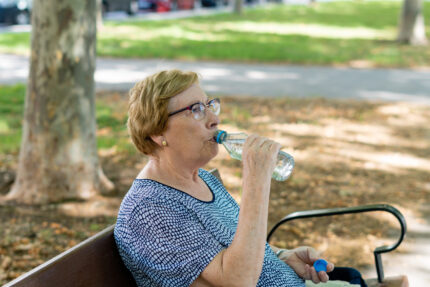
Extreme Heat Awareness Month is in July, but overheating can happen at any time of year. And exposure to very high temperatures, both in- and outdoors, can lead to a number of heat-related illnesses and even death in certain cases. It’s also important to keep in mind that some groups, including hospice and home health patients, are affected more severely by the heat. With a little planning, however, you can take steps to keep your loved ones safe and prevent conditions like heat exhaustion and heat stroke.
Dangers of extreme heat
The National Weather Service explains that heat-related illness happens when your body gets too hot and cannot cool itself down. Though normally, your body can lower its temperature by sweating, in extreme heat and humidity, sweating isn’t always enough.
There are different types of heat-related illnesses, ranging from mild ones like heat cramps and heat exhaustion to more severe conditions, like heat stroke.
Heat stroke happens when your body temperature gets too high — 104°F or higher — and stays high. Heat strokes are life-threatening and require immediate medical attention.
Essential heat safety tips for hospice and home health patients
For hospice and home health patients, the risk of heat-related illnesses can be higher because of health conditions and medications. Additionally, older adults are more likely to overheat if they wear too many layers, have to wait outside for a bus or other transportation, or have a hot home.
Follow these heat safety tips to protect your loved ones from the heat.
Hydrate often
Drinking water can help your body stay cool. According to the American Red Cross, it’s important to drink before you’re thirsty, so you don’t get dehydrated. Many medications increase your risk of dehydration, requiring you to drink more fluids than you normally would.
If you’re caring for someone, offer them water regularly. Keep water in every room, so it’s easy to access. You can also provide other cool drinks, ice, or popsicles. Many foods contain water, including fruits and vegetables. Lighter, cold meals are better on warmer days, instead of heavy, hot meals.
Whatever your method for increasing fluids, try to avoid caffeine, sugar, and alcohol. These ingredients actually dehydrate you instead of providing the water you need.
Limit outdoor time
Especially during the hotter months, be aware of heat waves and heat advisories, so you know when to stay inside. In general, it’s best to avoid the outdoors during the hottest times of day, usually 10 a.m. – 4 p.m.
When you need to be outside, take a lot of breaks to give the body time to cool off. As a caregiver, make sure the person in your care has a shaded, cooler area available. Avoid staying outside in the direct sun for extended periods.
Wear protective clothing
How you dress is important in hot weather. The National Institutes of Health (NIH) recommends wearing loose clothing that wicks away sweat to keep you cool. Cotton and natural fibers are usually more breathable. Light layers can be helpful to take on and off as you go from the hot outdoors to colder air-conditioned rooms.
Along with clothing, wearing sunglasses, wide-brimmed hats, and sunscreen protects you from the sun’s rays. To lower body temperature, consider adding ice vests and cooling neck wraps.
Take breaks in a cool environment
One of the best ways to prevent overheating is by sitting in a cool environment. Fans and air conditioning are great ways to keep a home at an appropriate temperature in the summer. If your home doesn’t have air conditioning, see if you can visit a public place, such as the mall or library. The Eldercare Locator tool can also help find local public cooling spots.
Caregivers should make sure a patient’s living space is cool and comfortable. Along with air and fans, a cold washcloth on the neck, a cool shower, or a wipe-down can make a difference. Cool, wet socks or sitting with the feet in cold water is another cooling method.
Check for signs of overheating
During the hotter months, it’s extra important to check on others often. Caregivers should look for any signs of overheating, such as:
- Confusion
- Dizziness
- Excessive sweating or no sweating
- Fatigue
- Headache
- Heat rash
- Muscle cramps
- Nausea
- Weakness
If you notice these signs, go to a cooler environment and hydrate. If you suspect heat stroke or something more serious, get medical help right away.
Monitoring the home environment
Home health care and hospice providers can help prevent some of the serious effects of heat exposure by monitoring the home environment. Regular checks ensure patients stay hydrated and cool. Patients may need adjustments to their care plan or medication during hotter times of year.
At Traditions Health, we offer compassionate, professional home health services and hospice care. We’re here to support you in many ways — including the prevention of heat-related illnesses. To learn more, please contact us by submitting a request care form.